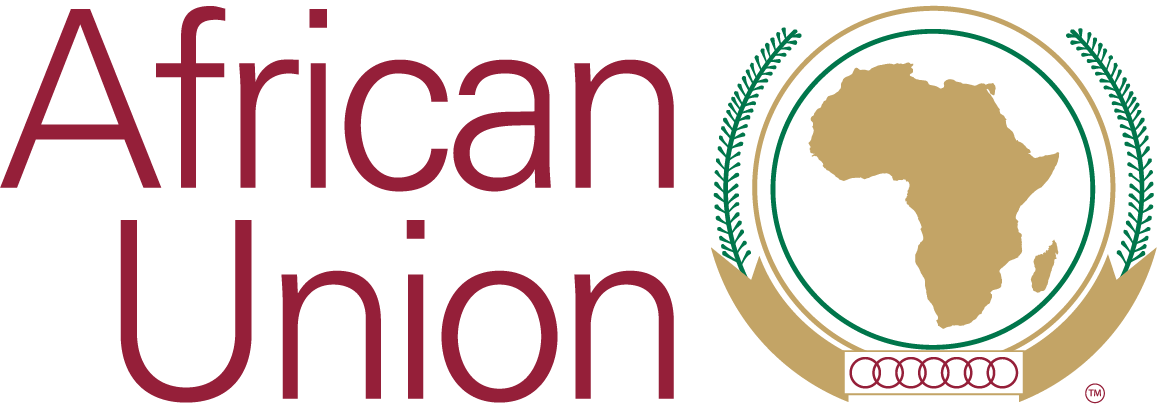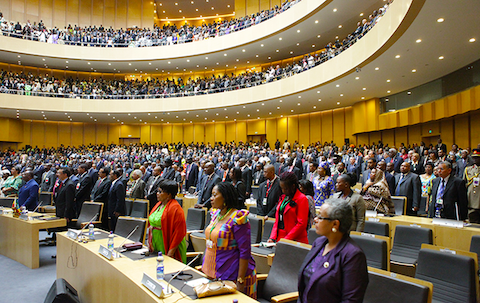Notes for the Chairperson of the African Union Commission, HE Dr. Nkosazana Dlamini Zuma to the 2nd African Editors Forum and AU Commission Roundtable on Agenda 2063
Notes for the Chairperson of the African Union Commission, HE Dr. Nkosazana Dlamini Zuma to the 2nd African Editors Forum and AU Commission Roundtable on Agenda 2063
Notes for the Chairperson of the African Union Commission, HE Dr. Nkosazana Dlamini Zuma
to the
2nd African Editors Forum and AU Commission Roundtable on Agenda 2063
Pretoria/Tswhane, 24 October 2016
CHECK AGAINST DELIVERY
Ms. Emrakeb Assefa, Executive Secretary of The African Editors Forum
Chairperson and leadership of the African Editors Forum and other Members of the Fourth Estate
Commissioners and Staff of the AU Commission
Ladies and Gentlemen
It is a great pleasure to welcome all of you, many who have travelled from across the continent to this 2nd Africa Editors Forum and AU Commission Roundtable on Agenda 2063.
A special word of gratitude to The African Editors Forum and our hosts the South African National Editor’s Forum and the SA Government’s Communications and Information Services, for the arrangements towards this second Roundtable.
A special welcome to editors and journalists who attend this Roundtable for the first time, and to the South African journalists, whom I believe are here in their numbers, rightly so as the hosts.
Ladies and Gentlemen
At the conclusion of the 1st African Editors and AU Commission Roundtable held in Kigali three months ago, we agreed on four major conclusions:
- To explore the issue of observer status for The African Editors Forum in the AU;
- To raise the issue of the persecution of journalists with Member states, in line with relevant AU instruments;
- To popularize and advocate for Agenda 2063 and its flagship projects, in particular the African passport; and
- To foster a better and inclusive African media landscape, which in turn should contribute towards crafting a progressive African narrative.
Let me start with the two ‘housekeeping matters’.
On the issue of the African Editors Forum observer status in the African Union, we have asked our Legal Counsel for direction and options on this, and the possible options are either for TAEF to become an observer as currently defined, with not much rights or obligations, or to become a specialized agency, which suggest a closer working relationship. I would recommend that the TAEF Secretariat consider working with the AUC on this, so that we can circulate a proposal amongst your member states and possibly table either option at the AU Summit in January 2017.
The second matter is that of the persecution of journalists by some of our Member States. As per your request, I raised this matter in my Statement to the Opening of the AU Assembly of Heads of State and Government in Kigali, and the Chairperson of the African Commission on Peoples and Human Rights raised this in her intervention on the debate on the Summit theme of Human rights with particular focus on the rights of Women.
Of course these are statements and declarations, which help raise awareness about freedom of the press, but has not stopped persecution of journalists. We therefore urge TAEF to continue to work with the African Commission on Peoples and Human Rights, to keep the spotlight on this issue. It being the year of Human Rights with an emphasis on women’s rights means that this matter urgently requires a joint programme and actions by the AU and TAEF.
The other issues of, advocacy around Agenda 2063, a conducive environment for African media, and the shaping of a progressive African narrative are matters that I would like to address in more detail in my statement today, in addition to the issues of the impact of new media and your views on the issues I raised in Kigali on women in the media.
To start with I am certain that you would all agree that the implementation of the Agenda 2063 requires that we continuously engage and work together to improve the developmental landscape of Africa. To this end, I would propose that this Forum meets at least once a year to review our joint actions, in addition to hosting similar engagements at a regional level. This will bring about depth to our relations and facilitate for better interaction.
Participants, Clearly implementation of our programmes has started. The framework for an integrated Africa, a continent that is prosperous, and to silence the guns and end the hot spots, has been established. An agenda which is driven by its own citizens has been set.
For all of us to succeed we will need to involve our citizens more and more. This is the role of you the editors and media owners.
The Agenda is about our people enjoying shared prosperity, peace and being the drivers of this continent.
The 10-year implementation plan speaks of the areas we cannot progress without. Things such as closing the skills gap, we need a skills revolution. We need to empower our women, as they are the majority on this continent.
We are encouraging the institutions of learning to encourage young people to study agriculture.
I was in Cape Town last week at a forum called RUFORUM; in the space of 12 years they have trained Masters and PhD students. In Cape Town they had a competition for innovation and 50 winners from 800 applications. The innovation has to solve Africa’s problems it can just be innovation for the sake of it.
- Advocacy around Agenda 2063 and the African narrative
This joint forum was organised, in the first place, to ensure dynamic engagement with the African media on the continent’s fifty-year vision Agenda 2063. It is a vision for fundamental transformation, which we believe cannot be implemented by governments, the Regional Economic Communities and the AU alone. It needs the participation of the African citizens, in all their diverse sectors and views.
It must also include various continental institutions who work with us in the development and implementation of Agenda 2063 such as the UNECA, the African Development Bank (and other regional development finance institutions[1]).
The media is one such critical constituency.
Agenda 2063, to recap, is based on 7 continental aspirations, which are:
- A prosperous Africa based on inclusive growth and sustainable development
- An integrated continent based on Pan Africanism and the furtherance of Africa’s renaissance
- An Africa of good governance, democracy, respect for human rights, justice and the rule of law
- A peaceful and secure African Union
- An Africa with strong cultural identity, heritage, shared values and ethics
- An Africa with people driven development, especially women and youth, and caring for children; and
- Africa as a strong, united, resilient and influential global player and partner.
These aspirations of Agenda 2063 build on the foundations of previous continental frameworks such as the OAU Charter, the Lagos Plan of Action, the Abuja Treaty and NEPAD, as well as sectoral frameworks in agriculture, science and technology, infrastructure, governance, industrialisation, peace and security and so forth.
Its first 10 Year Implementation sets specific goals at country, regional and continental levels in each of the priority sectors, and it has identified strategic flagship projects in these priority areas. These flagship areas include the African skills revolution with focus on STEM and youth employment; women’s empowerment; infrastructure development, agriculture and agro-processing; industrialisation and growth of intra-African investment, trade and businesses; and democracy, peace and inclusive governance.
African integration, without which we wont achieve the ambitious goals set out in Agenda 2063 therefore remains critical, and progress (or setbacks) in any of these priority areas impact on all the other areas.
Let me take an example of one such flagship project, the creation of a Single African Aviation Market. In 2004, African airlines carried less than 40 million passengers, this nearly doubled to 73.8 million passengers in 2013. In 2014, the entire industry supported 6.8 million jobs, and is set to grow by 6% a year over the next few decades. And yet, according to ICAO, our failure to implement the Yamoussoukro Declaration, which commits Africa to a single market, has seen us loose close to 40% of air traffic within and to and from the continent.
Since January 2015 thirteen[2], countries to date are working together to amongst themselves lay the foundation for the creation of this Single Aviation Market by 2017.
Let me use a second example.
One of our aspirations is an Africa with strong cultural identity and heritage. African cultural life has always flourished, even under harsh conditions of slavery, colonialism and dictatorship. It has a rich heritage, with advanced architecture in the Sudanese and Egyptian pyramids, Ethiopia’s Obelisks, the Tunisian city of Carthage, the ruins of Great Zimbabwe as well as the old city of Timbuktu in Mali to mention a few; and the sculptures of Makonde of Tanzania, the Benin Bronzes of Nigeria, the beautiful paintings of the Drakensburg and Algeria, various artistic creations of the Egyptians demonstrate to us a continent with a great heritage.
This is in addition to our rich biodiversity (on land and the oceans), our majestic mountains, rivers, lakes, forests, deserts and Savannas, as well as pristine beaches and islands.
In contemporary global culture, Africa too holds it’s own. We are home to the third largest film industry, Nollywood; our writers are a key part of the global community of writers, and new talent continuing being discovered; and the same goes for African art and music. We also have what the AfDB calls fashionomics, the rise of African fashion on the continent with the rest of the world, taking note.
All this coupled with the fact that we are the world’s youngest continent, an increasingly technology-savvy young generation, women and girls who are asserting their rights to participate and have a voice, means that this aspiration is far from a pipe dream.
What role do we then expect from the media in this advocacy for Agenda 2063?
If we for example take the coverage of the recent tragic train accident in Cameroon, which killed 70 passengers and over 600 injured, apart from reporting that the train was overloaded because of a collapse of a bridge which forced more people to use the train and that the railroad was 30 years old. As African journalist, reporting on this, we would expect you to cover the eyewitness accounts, but also to investigate whether there are plans to upgrade and develop the rail system; a critical Agenda 2063 infrastructure priority.
But, not only should we contextualise newsworthy stories, but we must also ensure sustained coverage of the issues critical to African development and people.
As we talk about defining and an evolving African progressive narrative, it seems to me we can learn some lessons from what those in your sector call ‘development journalism’. One definition of this is
the kind of journalism that pays sustained attention to the coverage of ideas, policies, programs, activities and events dealing with the improvement of the life of people.[3]
Yet another definition refers to it as
analytical interpretation, subtle investigation, constructive criticism and sincere association with the grass-roots
Another report argues that it is journalism which also:
- Overcome journalistic cynicism and acknowledge the possibility that citizens working together might be able to solve some of society's problems.
- Move "beyond only describing what is 'going wrong' to also imagining what 'going right' would be like."
- "Invite ordinary citizens back into public life by making their concerns the starting point of the debate."
- Move "from people as consumers ... to seeing them as a public, as potential actors in arriving at democratic solutions to public problems;" and
- "Modify the rules of detachment by accepting that journalists have an interest in and responsibility for raising the level of public discourse and helping society find solutions to its problems."[4]
Now this type of journalism has had its bad rep, simply being regarded as praise-singers of government.
However, as African journalists and media, we should be concerned about whether the lives of people are improving, and to report on a sustained basis whether we are making progress with a disease such as malaria, that still kills nearly 400,000 people a year, and on the African Centre for Disease Control, to prevent the recurrence of the devastation that Ebola wrecked on Guinea, Liberia and Sierra Leone not so long ago.
Since the Kigali Summit, we have been following your sustained coverage of the issues of the African Passport, and the decision on the Financing of the African Union, both issues critical to African integration and development. We also look forward towards your sustained coverage and analysis of progress with the Continental Free Trade Area, on African skills and developments in science and technology, and engineering, on agriculture and agroprocessing.
We must give voice to our grassroots, their efforts to improve their lives, and how governments, business, civil society, the media and others can contribute to give them access to information, so that they become part of a continental drive towards inclusive and shared prosperity.
- Impact of the new media and changing landscapes
Ladies and Gentlemen, there are a number of critical reports that have emerged from your sector, about the state of media on the continent, not least the publication by The African Editors Forum on 50 years of African media since Ghana’s Independence, and the report by Isaac Esipisu and Nixon Kariithi on New Media in Africa, to mention but two.
These and other reports and studies provide important historical data on the evolution and roots of African media – from oral traditions to print, and broadcasting – as well as the issues of ownership in the sector, and the evolution of new media on the continent.
This is important work, which you need to continue doing, so that we keep generating our own knowledge about the African media sector, critical to public policy, as well as to the training of new generation of journalists.
The second report by Esipisu and Kariithi mentioned, talks about three broad trends:
- The first trend is notable progress over the last 15-20 years towards democratization and media diversity, with the steady emergence of ‘mainstream, alternative and new forms of media such as community and privately owned commercial media, growing in numbers and diversity of opinion.
- A second trend of a surge in the take-up of information technologies, and therefore the use of new media, including what they call ‘pioneering grassroots media initiatives leveraging ICTs; and
- Thirdly, as new media entities emerged, the stagnation of state-owned media, equally important for public media in the face of competition and diversity.
All three trends have important implications for what we called in Kigali for ‘a better and inclusive African media landscape,’ and indeed are interlinked.
We must continue to support media diversity, and in particular community and grassroots media initiatives, but also continent-wide media and publishing initiatives that can give strong Pan African perspectives.
The new media usage is growing at a phenomenal rate on the continent, and must be integrated into the African narrative and discourse on development. As for more traditional media, who generates content and what content is generated, remains important in pursuit of Aspiration 5 of promoting a strong African identity.
- The Public Broadcaster and the Development of language
And thirdly, public broadcasters not only play an important role in public information, alongside community media, but also in the development of African languages. There is therefore an urgent need for them to come together to address the stagnation, whether real or perceived.
All of the above have implications not only for the training – in both journalism schools and on the job – of journalists, but it seems to be a need to reconsider the definition of the media labour market.
For example, are their careers in blogging, vimeos or the host of other social media activities that have emerged and flourished? What more should we be doing to encourage young African new media entrepreneurs, to support them and encourage more to develop?
Ladies and Gentlemen, At the 1st Roundtable in Kigali, I also raised questions about the extent of participation of women in the media – as professionals and owners – as well as their voices in the media. I hope that three months later, you have some answers to these issues.
Let me conclude by wishing this second roundtable all success, and looking forward to it becoming a regular institution.
I thank you.
[1] DBSA, ECOWAS bank, AfriExim, PT bank, BOAD, etc
[2] The 13 countries are Angola, Cote d’Ivoire, Ethiopia, Mauritius, Egypt, Togo, South Africa, Kenya, … For statistics on African aviation industry, see Giving wings to African Regional Integration, UNECA. 14 September 2016 and Aviation: Benefits beyond borders by the Air Transport Action Group. 2016
[3] Alan Chalkley (1968)
[4] What is Developmental Journalism? Films for Liberation, 8 December 2014. http://filmsforliberation.com/Fillfullarticle.aspx?Article=240
Topic Resources
Agenda 2063 is Africa’s development blueprint to achieve inclusive and sustainable socio-economic development over a 50-year period.
Report of the Chairperson of the Commission on the Situation in Somalia
Agenda 2063 is Africa’s development blueprint to achieve inclusive and sustainable socio-economic development over a 50-year period.











